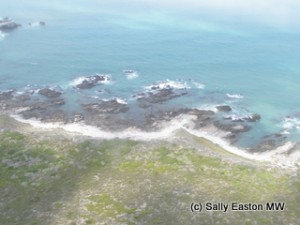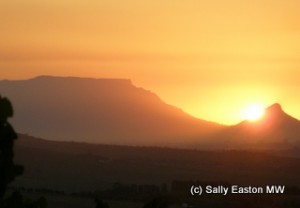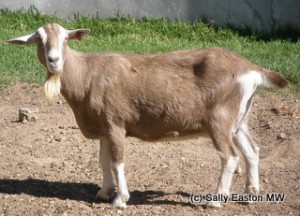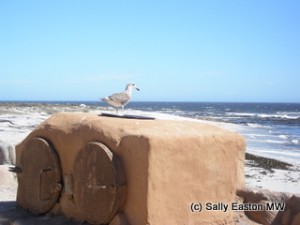Coasts and cuisine in South African currents
A version of this article first appeared in Food Development magazine, June 2009.
The defining moment for South Africa that the world knows was the release of Nelson Mandela in 1990. Four years later the rainbow nation achieved democracy.
As far as South Africa’s wine industry is concerned, it may well have the longest viticultural history of all the new world countries, with wine first being made there in 1659, during the times when the Cape was a stopover trading and refuelling post on the great sea routes. But the latest liberating chapter in the country’s renewal was the early 1990s scrapping of a quota system which dictated what was grown and where it was grown. And exports were freed up once the old controlling state co-operative was privatised in 1997.

Flying by Elim vineyards, Indian Ocean
Since then it seems that everyone has been fleeing to the coasts and the cooling coastal breezes to find new and different places to grow grapes. A big chunk of the vineyard is already ‘within sight’ of the oceans – the saying goes if you can see the ocean it’s a good place for a vineyard, presumably because of those cooling breezes, though quite how far inland they reach and actively moderate the vineyard climate is not always clear.
Closer to the coast there’s no argument, leaves waft in afternoon breezes. And with this great proximity to the oceans, Cape South Africans can satisfy two great passions simultaneously: making wine, with sauvignon blanc most definitely being flavour of the moment, and messing about on the water, in this case rather serious water in the guise of the Atlantic and Indian oceans. In the decade since 1997, sauvignon blanc plantings have increased from 5 to 8% of the vineyard area. And sauvignon blanc goes pretty well with fresh and simply prepared fish.
But there’s much more to Cape cuisine than fish, and Stellenbosch, at about 20 km from the sea, is the heart of the Cape Winelands, and nearby wineries long ago took the lead to offer local foods with the local wines. Indeed Delheim, less than 10 minutes from the town, were one of the earliest down this route when they started serving cheese platters in 1976.

The view from Delheim
Proprietor Nora Sperling-Thiel said they “started serving food as guests arrived in middle of day and were looking for something to eat, so we kept it simple with fresh farm bread cheese and paté. At the time we were the only farm with a restaurant and served 50 guests at a time but did two sittings a day in high season.” Now they have a busy lunchtime restaurant serving local food to accompany their wines. Their Pinotage rosé has become something of a legend in its own lifetime.
A little further toward Paarl, Fairview has built on its long association with homemade cheeses as well as wine. Four years ago owner Charles Back turned his old winery into The Goat Shed, a breakfast and lunchtime restaurant that’s packed to the rafters at weekends. The dirt paddock at the front has become tailored lawns dressed with tables and chairs immediately next to the closest vineyards.
To keep some of the winery feel, and to break up the large space, Charles said: “we cut out the concrete tanks by three quarters. And” he said “we wanted to use local people, and the kids of the farm workers. It took a lot of training, it took us a year to come out of the woods” while new staff got to grips with the service culture and the professionalism required to efficiently wait tables. And no surprise given the restaurant has more than 200 covers. Charles added that having the restaurant meant his “finger is on the pulse, because it elevates wine into the food environment. You have to focus on where you’re going; and you have a product testing-ground on site.”

A Fairview Goat
As well as the Fairview range, Back also makes the Goats do Roam and Spice Route ranges, so the restaurant has plenty of opportunity to test plenty of products. With so many wines, Back sources fruit from some of the newer vineyard plantings, and his Spice Route sauvignon blanc comes from the Darling region, an hour’s drive north of Cape Town, about 10km inland from the Atlantic Ocean, which he said: “is a seaward facing vineyard, getting breezes off the coast. The vineyard gets 5-6°C lower than [Paarl], and the harvest is about a month later.” This later ripening helps preserve some of the typical zesty and grassy characters in sauvignon blanc.
Futher up the West Coast, about 300km north of Cape Town, is an even more recently planted vineyard area, around Lambert’s Bay, where the Sir Lambert property can be found, and Fryer’s Cove, lying another half an hour north on a dirt track. Both are producing light, zesty, grass and lemongrass style sauvignon blancs, which are back on track with the local fish at the key attraction of the region, the Muisbosskerm restaurant, an all-South African experience.

View from Muissbosskerm
The Muisbosskerm is as close to the Atlantic coast as it’s possible to get … being on the beach. It takes its name from temporary shelters made from the local mouse bush plant. The restaurant started out feeding family and friends, but it’s been a highlight on the tourist trail for many years, and it’s the clients who have to turn up on time for the freshest straight-from-the-ocean fish. Those local sauvignon blancs match well the atmosphere and the open-grilled and baked kingklip, hake, crayfish, snoek, steenbras and Cape salmon fish braai, whatever’s in season. The traditional stickily-sweet sweet potato somehow works well as one of the accompaniments.
In 2009, the South African wine industry celebrated its 350th birthday, but it’s the freshness of the last decade that’s getting folk really excited as producers carve out a new identity for the 21st century.
This article was inspired by a visit to the Cape winelands in March 2009, sponsored by Wines of South Africa.



